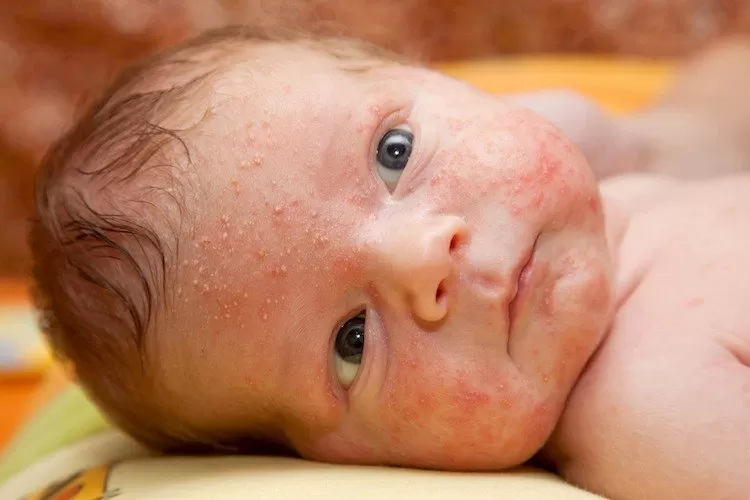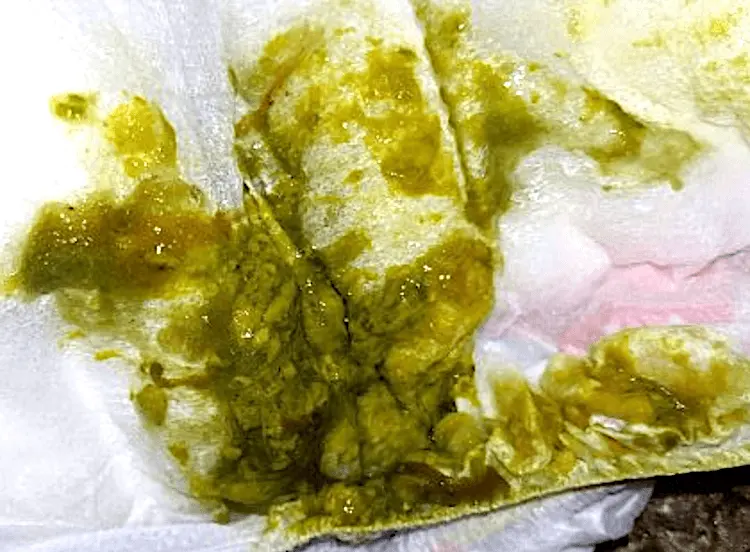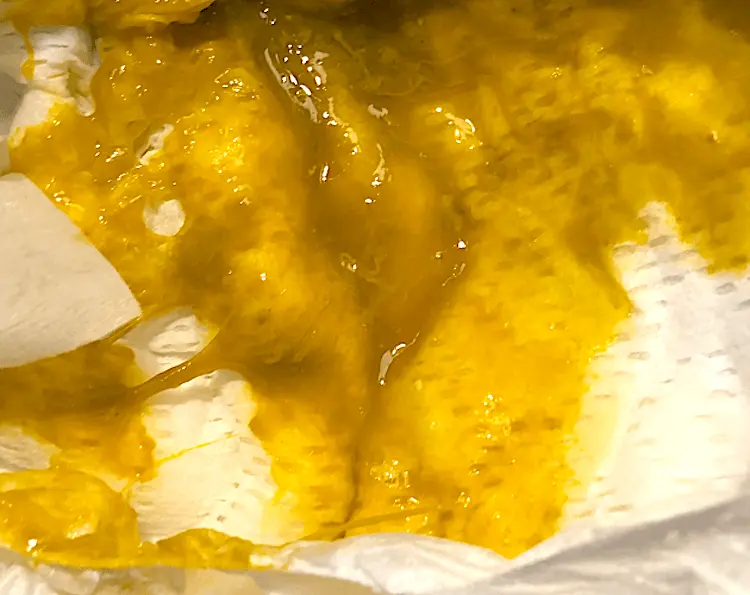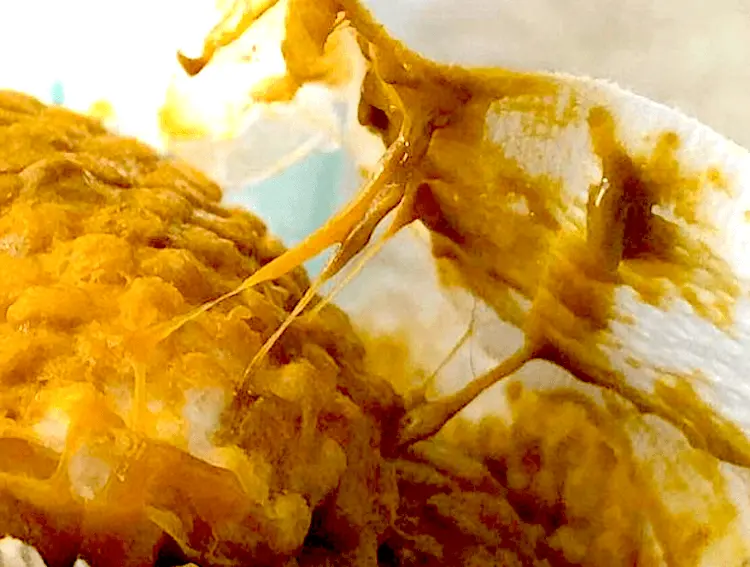Milk allergy baby poop pictures are a good way to help identify if your baby has cow’s milk allergy, or CMPA. This post provides visual examples.
Milk Allergy Baby Poop Pictures Can Be a Helpful For Identifying CMPA

Are you wondering whether mucus in baby poo, red blood in breastfed baby stools, or green baby poop is normal? Or perhaps you’re now at the point of searching for milk allergy baby poop pictures to help you figure out what’s going on for your little one.
This can be a really stressful situation for new parents, and you’ll most likely be feeling anxious, concerned, and probably exhausted too. I’ve been where you are with my baby girl, and I understand the worry and apprehension only too well.
On the one hand, you don’t want there to be anything wrong with your infant; on the other you’d be relieved at this point to finally have some answers for what’s going on. Especially if one of the current issues you’re dealing with is colic, which can be another allergy symptom and in my experience is totally draining.
CMPA is now the most common food allergy according to the NHS1, and is caused by the immune system overreacting to certain substances.
It can sometimes be really helpful to make a visual comparison of specific conditions with your own baby. For more information about allergy symptoms as well as pictures of the differences between a cow’s milk protein allergy rash and other skin conditions in infants, see my post about the signs of a dairy allergy.
This information is based on my experiences with my allergy baby and should not replace the advice of a healthcare professional.
What Does Healthy Baby Poop Typically Look Like?
Baby poop differs in colour and texture according to age and diet, even in a healthy baby.
A newborn’s first poop, called meconium, is thick and black, almost tar-like in appearance and consistency. This is completely normal for a first bowel movement and occurs as a result of the various substances in your newborn’s stool at birth, including amniotic fluid.
After the meconium passes, baby poop changes and you can expect your infant to have a transitional stool which will be looser and more yellow-green in colour.
Subsequent changes will depend largely on whether your baby is breast fed or formula fed.
Breastfed babies tend to have soft or runny yellow or green poop, or it may be more brown and contain little seed-like flecks.
Baby poop color for formula-fed babies on the other hand will be yellow or brown and thicker, similar in appearance to peanut butter.
At around six months solids are introduced, and this is when you can expect to see new changes in your baby’s diaper.
How Can Mom’s Diet Affect Baby’s Poop Color?
If you’re nursing your baby, it’s worth noting that your diet can change the color of your baby’s stool.
For example, taking an iron supplement may cause black poop in the mother, and potentially also affect the infant. Note that iron tablets may also cause gastrointestinal symptoms more generally.

How Can Nursing Affect Infant Stools?
A nursing mother’s milk is made up of foremilk and hindmilk. The first milk, foremilk, is low calorie and is designed to quench thirst, before the richer, fattier hindmilk comes in to satiate your infant’s hunger.
A hindmilk imbalance can change the color of your baby’s poop, turning it green.
If your baby is not getting enough hindmilk, try feeding for longer on each side before switching to the other breast.
A Milk Protein Allergy Poop Picture is Worth a Thousand Words
What’s normal, and what’s not?
In this post I’m focusing on another more delicate symptom: your baby’s dirty nappies. Because, while checking your baby’s skin for rashes can be helpful as a diagnostic tool, a holistic approach is going to be far more use in helping to identify what’s going on for your infant.

But when it comes to baby’s poop, what’s normal, and what’s not?
What Does Milk Allergy Baby Poop Look Like?
Well, to be blunt, it’s not pleasant.
That said, it’s important to note that not all babies with a dairy allergy will also present with the types of nappy which are often associated with cows’ milk allergy.
Keep in mind the only definitive way to confirm an allergy is via an elimination diet.
It’s necessary to look at all of your baby’s symptoms together in order to make an informed guess at the issue, and then take your suspicions to your GP or a paediatrician for a formal diagnosis.
It’s worth noting also that with or without a diagnosis from a qualified doctor, the only was to definitively confirm an allergy is by eliminating the allergen and observing an improvement in/resolution of symptoms.
Distinguishing Features of Milk Allergy Baby Poop
Typical characteristics present in the dirty nappy of a baby with a dairy allergy include:
- Watery stool
- Green stool (diarrhoea)*
- Bloody stools
- Mucus in the stool
*Note that as mentioned above, green poop can be completely normal in infants. This is why it’s important to look holistically at your baby’s symptoms.
Keep in mind that your baby’s diet will also have a bearing on their nappies. As they get to around six months old and go on to solid foods this will almost certainly affect their stool. It’s likely to become firmer, and its colour may reflect the foods in their system too.
Cow Milk Allergy Baby Poop Pictures
Okay, it’s a bit grim, but the reality is you need to see what you’re dealing with. Following are some examples of the types of dirty nappy you can expect to see from infant’s with a milk allergy:
Blood in Infant Stool Pictures

Blood in your baby’s nappy is not a reason to panic and does not necessarily point to an allergy. I recommend seeking medical advice from a health professional for guidance if you’re concerned, but it’s worth being aware that the following can cause blood (or a red colour) in a baby’s stool:
- Some red foods in the mother’s diet (breastfed babies),
- Bleeding nipples in the mother can lead to blood in breast milk entering the baby’s system (breastfed babies),
- Constipation and straining,
- Diarrhea (do not ignore in a baby as this might indicate an underlying issue and may lead to dehydration which can be serious),
- Haemorrhoids,
- Infections,
- Food allergies.
The blood or red colour can be harmless, but it’s sometimes a clue to an issue that needs to be addressed. If you have any doubts seek advice from your GP or health visitor.
Green Mucus Baby Poop

Green baby poop can be fine; it’s sometimes an indication of over-supply in a breastfed baby (mum will likely be aware of this!), or may occur with antibiotics taken by mum or baby.
However green baby poop along with other symptoms can also be a sign of an allergy, especially if mucus is also present.
Mucus in Baby Stool


Mucus in baby poo is often a symptom of an allergy to dairy proteins.
Lactose Intolerant Baby Poop
Lactose intolerance is not the same as a dairy allergy, though it is caused by a similar issue: lactose intolerance involves the inability to adequately break down the sugar in milk, as opposed to an allergic reaction to milk proteins.
Symptoms of lactose intolerance can overlap with those of CMPA.
Also note allergies can be triggered by even a tiny particle of the allergen and in severe cases cause dangerous symptoms, while a dairy intolerance usually means a small amounts of the offending food can be tolerated without a problem.
One of the severe symptoms of cow milk allergy (or any allergy) can be difficulty breathing, in which case you should seek urgent medical attention.
While this post is focused on allergies caused by dairy products which is different to lactose intolerance, the symptoms and images here may also indicate a lactose intolerance, which is just one of the reasons it’s important to verify the issue. Here’s more on how to confirm a milk allergy.
How to Manage CMPA
The way you choose to care for your CMPA baby will depend on whether or not you’re nursing, but ultimately you will need to remove the allergen from your infant’s diet.
For breastfeeding mothers, you’ll need to completely cut dairy (and possibly soy) out of your own diet in order to eliminate it from your breastmilk, or you may choose to switch to formula.
For those babies who will be formula-fed, you’ll need to switch to a hypoallergenic formula which is specially formulated for baby’s with a dairy allergy.
For more support with feeding and caring for an infant with an allergy, the following posts may be helpful:
You may also find it helpful to keep a record of your/you’re baby’s diet whilst going through the process of confirming an allergy. I designed this allergy food diary specifically with breastfeeding mums in mind.

Finding out your baby has an allergy is daunting and stressful, but knowing what you’re dealing with makes it that much easier to manage. You will get through this.
Sources
- Causes of Food Allergy, NHS

Maria
Tuesday 19th of July 2022
My daughters poop looks like that with the mucus and sometimes small specs of blood .. but she doesn’t show any other signs that she’s irritable or anything else and sometimes she will get a pimple but then it goes away
Dani
Thursday 15th of September 2022
@Kate Tunstall, how long does it usually take for symptoms to go away with milk allergies in babies
Kate Tunstall
Wednesday 20th of July 2022
Hi Maria,
I'm sorry to hear about your daughter.
If you have any concerns at all please consult your GP or health visitor.
Wishing you the best of luck.
Unique
Sunday 19th of June 2022
I will definitely be bringing this up to my doctor poor thing cries all night and this may be why. Thank you so much
Kate Tunstall
Sunday 19th of June 2022
I'm sorry to hear that - it's such a stressful time. Best of luck with you're little one.
Christine
Thursday 16th of June 2022
This was so helpful! Thank you!
Kate Tunstall
Thursday 16th of June 2022
I'm so glad. Wishing you lots of luck with your little one.